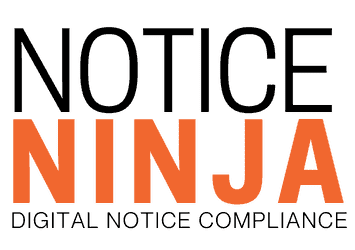Yes, NOTICENINJA is corporate tax notice compliance software that automates key workflows including notice assignments. The platform employs a rule-based system that can manage multiple level rules and ensure notices are directed to the appropriate stakeholder. As a result, you’ll never have to worry about notices being misdirected or slipping between the cracks.

Turning Data Strategy into Business Value

01 May
A Playbook for Tax Leaders Driving Growth and Efficiency
Recently, a leading finance and tax transformation webinar made a powerful case: tax departments that treat data strategy as a business discipline — not a compliance afterthought — are the ones positioned to drive measurable executive value.
Building on those insights, we've outlined a practical playbook for tax leaders ready to move from compliance management to strategic growth enablement.
Tax teams today aren't just expected to file returns or respond to notices. They're expected to deliver strategic insights, improve operational efficiency, lower risk profiles, and support corporate growth initiatives.
The question isn't whether tax technology matters. It’s how your tax team can use data to prove its value to the business — faster, smarter, and more visibly.
Stage 1: Map Your Current Data Environment
Before you can transform, you have to see clearly.
If your executive team asked for a real-time view of open notices, pending refunds, and in-flight audits — could you deliver it?
Most tax teams can’t. Not because they lack expertise, but because their data is fragmented across emails, spreadsheets, and disconnected systems. When a tax issue escalates, response times slow, P&I costs grow, and leadership loses visibility.
This isn’t just a workflow issue — it’s a credibility gap. And it’s exactly where a smarter tax data strategy begins.
To build that strategy, start with a diagnostic of where things stand:
- Where and how are tax notices currently received and tracked?
- How are audit requests assigned, monitored, and escalated?
- Is there a centralized system for logging amended returns and refund activity?
- How easily can you pull jurisdiction-level data across departments or entities?
- Can leadership access a single view of tax exposure at any given time?
Outcome Focus: Build a business case around hidden inefficiencies and visibility gaps — and use that insight to define your modernization roadmap.
Stage 2: Define KPIs That Align to Business Outcomes
Strategic tax teams don't just manage compliance — they measure and communicate business impact.
Define KPIs that align directly with financial and operational goals, such as:
- Reduction in total penalties and interest (P&I) costs
- Decrease in time to resolve tax notices or audit inquiries
- Real-time reporting of effective tax rate (ETR) across entities
- Accuracy of cash tax forecasts tied to jurisdictional risk
When tax KPIs mirror business metrics, it elevates the tax team's credibility and influence across finance and leadership.
Outcome Focus: Make tax performance measurable — and visibly connected to business value.
Stage 3: Identify and Connect Critical Data Sources
Tax data doesn’t live in one system — it’s scattered across the enterprise.
Identify and document key data sources critical to tax operations:
- ERP systems for GL transactions, asset ledgers, and intercompany flows
- Payroll platforms for employee state tax and withholding data
- CRM systems for revenue sourcing and customer apportionment
- Treasury systems for loan agreements and cash movements
- Compliance portals for regulatory reporting and notice management
Once mapped, the focus shifts to integration — ensuring tax workflows don't stall due to incomplete, siloed information.
Outcome Focus: Build a connected, dynamic data environment that supports compliance, insights, and risk management.
Stage 4: Integrate the Right Technology for Scale
Technology is not the destination — it's the infrastructure that powers strategic growth.
Focus integration efforts on systems that:
- Centralize notice intake, audit tracking, and refund monitoring
- Automate standard compliance workflows to eliminate manual risks
- Surface real-time alerts for upcoming deadlines, escalations, or anomalies
- Enable predictive modeling to anticipate cash tax impacts
NOTICENINJA, for example, connects seamlessly across finance and tax systems, giving tax teams a scalable, automated foundation without disrupting existing workflows.
Outcome Focus: Free up skilled tax professionals to focus on high-value advisory work — not administrative firefighting.
Stage 5: Implement with Executive Visibility
A successful rollout doesn’t just fix internal processes — it amplifies the tax team's strategic profile.
Prioritize pilot projects that deliver quick, visible wins:
- Accelerate tax notice resolution timelines
- Reduce manual hand-offs during audit defense
- Provide leadership with dashboards tracking compliance KPIs
Integrate executive reporting into the implementation plan from day one. Visibility into early wins builds support for broader transformation.
Outcome Focus: Turn every implementation milestone into a proof point that tax is a strategic enabler — not just a cost of doing business.
Stage 6: Leverage Data for Continuous Strategic Contribution
Real transformation happens when tax teams use their new capabilities to deliver proactive insights — not just reactive compliance.
With centralized data and smart automation in place, tax teams can:
- Anticipate tax obligations and cash impacts for upcoming quarters
- Proactively flag exposure areas and recommend mitigation strategies
- Provide real-time metrics for leadership reporting and audit preparation
- Quantify savings from risk avoidance, faster refunds, and lower P&I
Platforms like NOTICENINJA make it possible to move from manual notice resolution to full tax intelligence operations — changing the conversation from compliance lag to business leadership.
Outcome Focus: Position the tax team as a continuous contributor to growth, risk management, and executive decision-making.
Build Your Case, Lead the Way Forward
The future of tax leadership belongs to teams who see beyond compliance and build with intelligence. With a smarter data strategy and the power of NOTICENINJA, tax can shape business outcomes, strengthen executive trust, and lead the way forward.
Next Steps
Ready to turn your tax data strategy into a competitive advantage?
Download the Notice Ninja Implementation Guide and start building a smarter, more connected tax operation today.
RELATED POSTS
- Effortless Data Management: Introducing Batch Processing in NOTICENINJA
- Data Models: Revolutionizing the Complex World of Tax & Compliance
- Notice Ninja Introduces Open Endpoint API to Revolutionize Tax Data Management
